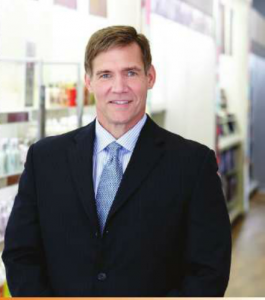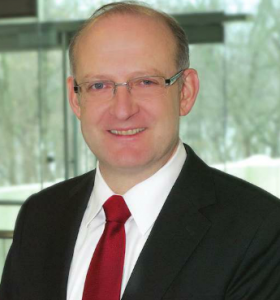As Seen in CFO Studio Magazine Q1/Q2 2016 Issue
IMMUNOMEDICS CFO PETER PFREUNDSCHUH HAS A KNACK FOR FINDING FUNDING IN ANY MARKET
BY MARTIN DAKS
Peter Pfreundschuh, 46, is the Chief Financial Officer of Immunomedics, a Morris Plains, NJ–based clinical-stage biopharmaceutical company that develops antibody-based products for the targeted treatment of cancer, autoimmune diseases (including Lupus and Rheumatoid Arthritis), and other serious diseases. He’s the kind of CFO who can juggle multiple responsibilities while maintaining a laser-like focus on lifeblood targets of any emerging growth biotech business, like raising and managing cash to achieve the target end goals.
Pfreundschuh is not a one-hit wonder. At Immunomedics and other companies across a string of industries, he has successfully closed more than $500 million of corporate financings, initial public offerings, debt refinancing, and other private placements.
“My primary focus is financing and business development, but a significant part of my job involves building relationships,” says Pfreundschuh, who joined Immunomedics in September 2013. This kind of duality has played a big role in the company’s growth, and has also been a significant component in his own professional development.
Immunomedics, for example, started out strictly as a diagnostic company many years ago — developing imaging and other products — but about 10 years ago the company revised its focus to concentrate primarily on antibody-based therapeutics.
“It can be a long path to develop and commercialize therapeutics, and you need a tremendous amount of capital,” Pfreundschuh notes, adding that the process of moving products from research and development through clinical trial is a winding path that can eat up funds at a staggering pace.
So it’s no surprise that Pfreundschuh has spent a considerable amount of his time helping Immunomedics to tap the capital markets, an effort that involves a lot of due diligence, a sharp eye on regulatory compliance, and a lot of face-to-face communication to help build trust.
“In May 2014, we had a successful capital offering that raised about $35 million,” he explains. “In that same year, at the annual meeting, shareholders approved a new shelf offering that gave us the ability to float a $100 million convertible debt to equity offering, which was completed in February 2015. This kind of funding enables Immunomedics to continue the drug discovery and commercialization activities that are vital to the company’s long-term future and success.”
Pfreundschuh says the 2015 debt offering was underpinned by relationships with two well-known investment banks: Goldman Sachs and Jefferies. “We had a preexisting relationship with Jefferies that was reinforced by this second financing, but we also had to help build the initial relationship with Goldman Sachs.”
He started the “getting to know you” dance right after joining Immunomedics; meeting with Goldman Sachs’ investment bankers and giving them an in-depth look at the company and its prospects.
To Capture Attention
In order for Immunomedics to float these kinds of offerings, “You have to know a great deal about your own business and its relationship to the capital markets,” he says. “But at the same time, you have to be a bit of a generalist, since you want to cast a wide net for investors, beyond specific biotech investors. You want to be able to capture the attention and interest of funds and other sources as well.”
During a career that has spanned about two decades since earning an MBA with a concentration in finance from Rider University and a BS in accounting from Rutgers University School of Business, Pfreundschuh has developed a lot of experience through his involvement in multiple capital-market financings.
Still, the September 28, 2008 stock market crash, which knocked out approximately $1.2 trillion in market value, also knocked the wind out of the sails of biotech and other financing for a long time, Pfreundschuh notes. It meant that CFOs like Pfreundschuh had to be even more aware of their company’s strengths and weaknesses, and the market in which they operate. So, before he made the rounds of potential funding sources, Pfreundschuh worked with management and the Board of Directors of Immunomedics to develop a long-term plan that reflected “a range of scenarios, and then we built our financing pitch around those bookends.”
It’s all about establishing credibility with the capital market, he explains. As part of the pitch, he helped to create a schedule of realistic milestones, or guideposts — including drug development milestones — that demonstrated awareness of the market, of his company’s own cash flow, and of the business’ development abilities. “Then we had to meet those milestones,” he says. “I was deeply involved in the road show, and had to understand the fundamentals of the business.”
He also had to understand the point of view of the potential investors, so he could anticipate their questions and ensure he had answers.
“It’s a bit like dating,” Pfreundschuh relates. “Each time you see each other you share a little more.”
If capital financing is like dating, Immunomedics is likely to be invited to a lot of dances. The company’s focus, oncology, continues to be a hot area, especially as traditional chemotherapy treatments are increasingly being replaced by targeted therapeutic agents that deliver drug treatment in an efficient, less painful manner.
“Large pharmaceutical companies need smaller, nimble ones like Immunomedics,” says Pfreundschuh. “Large pharmaceutical companies are good at developing and commercializing products, but need innovative growth companies like ours to develop the next new therapy from basic research, and investment money follows innovation.” Since 2013, for example, Immunomedics has been collaborating with giant multinational Bayer AG on oncology research in a business relationship that Pfreundschuh manages.
Immunomedics’ next big project involves expanding the company’s oncology portfolio. As CFO, Pfreundschuh will be tasked with securing funds to advance the company’s R&D efforts, and to find additional partners that can help to commercialize its products.
“We want to have more of a hand in the commercialization process,” he explains. “It’s the next logical step.”
The process also means that Pfreundschuh will be adding another hat, business development, to his portfolio of responsibilities. But that doesn’t bother him.
“It’s good that CFOs continue to get even more involved in the business,” he says. “At the end of the day I can go home and say I made a difference in people’s lives.”



